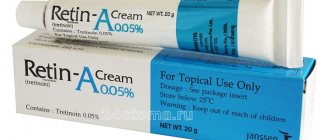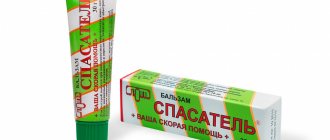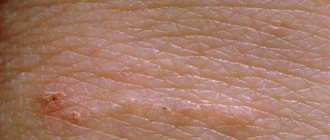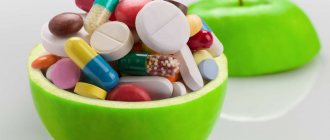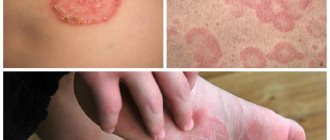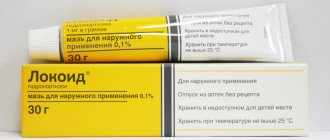Skin problems can arise at any age: during adolescence, acne appears on the face due to hormonal changes, and with age, the skin loses its elasticity and wrinkles begin to appear.
Retinoic ointment is a universal remedy for solving cosmetic problems; it is sold in pharmacies and is classified as a medicine.
What is Retinoic ointment
The main component of the ointment is isotretinoin, its content can be 0.05 g or 0.1 g. The substance is a biologically active form of retinol (vitamin A), which affects the process of cell differentiation.
Excipients include petroleum jelly, glycerin, ethyl alcohol, emulsion wax, dibunol, distilled water and butyloxyanisole.
The product is a yellowish substance of uniform consistency without inclusions. Packaged in tubes of 10 or 15 g, sold in boxes along with instructions.
How do retinoids work?
The mechanisms of retinoids that lighten age spots and even out skin tone:
- Inhibit tyrosinase
- Inhibit the process of pigment transfer into melanocyte pigment cells
- Normalize cellular renewal and stimulate timely exfoliation of pigmented horny scales from the surface of the skin.
- They stimulate keratogenesis - the appearance on the surface of the skin of cells with a normal, genetically programmed amount of pigment, i.e. normally colored.
- They work as conductors for other active ingredients, ensuring their deep penetration.
Retinoids are a group of substances derived from vitamin A. Due to their physiological effects on the skin, they effectively rejuvenate, eliminate acne and lighten the skin. Knowing the principles of operation and rules of application, Retinoids can achieve true correction of many skin problems.
Mechanism of action of Retinoic ointment
The instructions for Retinoic ointment contain information that the drug belongs to dermatotropic agents. This means that the composition protects the skin from microbes and parasites, stimulates the healing process and renewal of the epidermis.
Due to retinoic acid, the product provides:
- anti-inflammatory effect;
- exfoliating effect;
- antiseborrheic effect;
- dermatoprotective effect.
Isotretinoin has proven effectiveness in the treatment of dermatitis, normalizes the functioning of the sebaceous glands and thereby relieves acne, pimples and acne.
Glycerin present in the composition helps smooth the skin, and ethanol has an antibacterial effect and improves blood circulation. The medicinal composition is able to penetrate into the deep layers of the skin and inhibit the production of sebum, preventing the expansion of the diameter of the sebaceous ducts and their clogging with secretions. The ointment improves the removal of fat, due to which the inflammatory process is relieved, and the pores are narrowed, giving the skin a healthy and even appearance.
Retinoic ointment for wrinkles
Dermatologists who prescribe Retinoic ointment for the treatment of skin diseases note that as a result of use, the face is further transformed: the face becomes elastic, the skin is tightened and thickened, rashes and wrinkles disappear.
Conducted scientific studies confirm that isotretinoin, when applied systematically, is capable of:
- have a rejuvenating effect on the skin;
- increase elasticity and firmness;
- renew the epidermis due to intensive exfoliation of the dead layer of cells;
- improve skin tone;
- make the skin denser and thicker;
- restore tissue, smooth out deep wrinkles, including around the eyes, creases;
- indirectly stimulate the production of collagen, hyaluronic acid and elastin, which smooth the surface and increase tightness.
Thus, having noticed the first age-related changes, such as sagging skin, paleness of the face, wrinkles, start using Retinoic ointment, which can be applied not only to the face, but also to the shoulders, hips and back.
Contraindications
Retinoic ointment has clear contraindications for use, including:
- Pregnancy, including planned;
- It is also contraindicated in nursing women due to the possibility of passage into breast milk;
- Hypersensitivity and skin damage, the cause of which is not clear;
- Too thin and dry facial skin;
- Vitamin A hypervitaminosis;
- Fatty liver and lipid metabolism disorders;
- Treatment with tetracycline antibiotics;
- Treatment with other retinoids.
When the drug is contraindicated, side effects
Like any medicine, the ointment has contraindications for use:
- planning conception, pregnancy, breastfeeding (cannot be applied to large areas of the skin);
- taking other retinoid drugs to avoid overdose.
With caution, it can be used by persons with chronic kidney and liver diseases, chronic pancreatitis, and severe heart failure.
Undesirable effects may occur during treatment:
- personal intolerance to the substance and auxiliary ingredients;
- the appearance of new rashes from the second week of use, redness of the skin, which does not require cessation of therapy.
When used for a long period, increased dryness of the skin with peeling, conjunctivitis, inflammation of the mucous membrane and skin of the lips may occur.
How to apply anti-wrinkle ointment
If Retinoic ointment is used for wrinkles, then the following procedure must be followed:
- Cleanse your face of decorative cosmetics using toner.
- Dry the skin with a clean towel or dry cloth.
- Apply the ointment to the face and décolleté in a thin layer.
It is better to carry out the procedure once a day before bed to allow the drug to be absorbed.
You can apply the composition as a mask for 40-60 minutes and rinse with warm water, and then use a moisturizer.
It is important to understand that the result will become noticeable with regular use.
Drugs from the retinoid group are currently the most effective treatments for all forms of acne.
Why do we choose them?
Because they have a beneficial effect on all processes occurring in the skin when acne occurs - they reduce the production of sebum and facilitate its secretion, normalize keratinization, reduce inflammation, and prevent the growth of pathogenic microbes in the pilosebaceous follicles.
Systemic (internal) retinoid therapy
(Roaccutane or high doses of retinol palmitate) is usually used for severe forms of acne. For mild forms, it is more advisable to prescribe external agents with 13-cis-retinoic acid (isotretinoin). The domestic drug Retinoic ointment is available in two concentrations - 0.1% and 0.05%, which corresponds to the content of 13-cis-retinoic acid (isotretinoin). The ointment is made on an emulsion basis (that is, it has the consistency of a light moisturizing cream), has a yellowish color, is odorless, is easily applied to the skin and absorbed. What concentration to choose, what guidelines to use in order to maximize the clinical effect? This article is devoted to these issues.
A study of the safety of retinoic ointment at all three concentrations showed that the ointment does not have an allergenic, carcinogenic, mutagenic, embryotoxic or teratogenic effect.
At the beginning of the treatment of papulopustular and comedonal acne, use Retinoic ointment 0.1% to achieve maximum effect in a shorter time. The exception is people with thin, sensitive skin (mainly blondes, red-haired people and children), who initially use an ointment of a lower concentration (0.05%), increasing it if it is well tolerated, usually after 2-3 weeks. The ointment is applied twice a day in a thin layer to the affected areas (facial skin, if necessary, back and chest). When using a high concentration ointment on the face, do not apply it to the eyelids, area around the eyes, lips, corners of the mouth and at the entrance to the nose, and also avoid getting the drug on the mucous membranes to avoid irritation.
Almost all patients on the 5-8th days of treatment experience an exacerbation reaction, manifested in an increase in the number of rashes, moderate redness and peeling of the skin, sometimes dry lips, itching. The reaction lasts from 3 days to 2 weeks, does not require additional therapy and disappears on its own, giving way to persistent improvement. In case of a pronounced exacerbation reaction, stop using the ointment for several days until it subsides. Despite the fact that the instructions for use of the ointment mention the possibility of such a reaction, it is better to warn the patient about it. Our experience shows that it is sometimes regarded by patients as intolerance to the drug and treatment is stopped. It is better to schedule your next visit to a dermatologist 10-14 days after the start of treatment; it is at this time that patients have questions and doubts, they need support and confidence that everything is going as it should. After the exacerbation reaction subsides, improvement is noted - the oiliness of the skin gradually decreases, and resolution of the rash is observed. This favorable trend continues throughout the treatment period (usually 3 months), which does not exclude the appearance of a small number of new eruptive elements. There are usually no other side effects.
The best result is achieved with comedonal acne - cleansing of comedones and reducing skin oiliness occurs within 14-21 days. Deeply located closed comedones become more superficial. With papulopustular acne, pustules (pustules) and comedones resolve first, followed by inflammatory elements; spots, cystic elements and scars are the most resistant to treatment.
To increase the concentration of the ointment in those patients for whom it was considered more appropriate to start treatment with retinoic ointment 0.05%, it is better to choose a period when 7-10 days have passed after the exacerbation reaction has subsided.
What is considered drug intolerance? How to distinguish it from an exacerbation reaction and choose the right tactics for managing the patient?
In some cases, after the first application of the ointment to the skin, the patient is bothered by a burning sensation, itching, and redness occurs. With repeated applications, these phenomena are repeated and intensified, the erythema spreads to neighboring areas, swelling of the skin occurs, redness, rashes in the form of small spots and nodules, and peeling occur. If intolerance occurs, the drug is discontinued, further treatment is carried out with drugs from other groups (not from the retinoid group!). The tactics for treating intolerance phenomena correspond to those of allergic rashes. Intolerance differs from an exacerbation reaction in the timing of its onset, the rapid development of symptoms, the presence of swelling and induration, the appearance of rashes unusual for acne that are not confined to the mouths of the pilosebaceous follicles, and the spread of rashes beyond the application of the ointment.
It should be noted that an initial burning sensation that goes away after a few seconds can be observed in people with sensitive skin if the drug is well tolerated. It is due to the presence in the ointment of a small amount of alcohol used as an antimicrobial substance.
During treatment with retinoic ointment 0.1%, another phenomenon may occur - an overdose of 13-cis-retinoic acid. Clinical manifestations of its excessive accumulation in the skin are the appearance of flaky red spots both in the places where the ointment was applied and nearby (on the neck, abdomen, shoulders, forearms, hands). Subjectively, mild itching and a feeling of increased sensitivity of the skin in places of contact with clothing, as well as when touched, are noted. In such cases, there are 2 options - stop using the ointment until these phenomena resolve, and then start using it again at a lower concentration, or immediately reduce the concentration. An overdose occurs closer to the end of the course of therapy - in the second or third month of treatment.
The use of retinoic ointment 0.05% is indicated in the following cases:
- For thin, sensitive skin prone to irritation;
- In case of excessive accumulation of retinoic acid in the skin (overdose);
- In conditions of increased solar radiation;
- As a transition period to maintenance therapy;
- For conglobate acne in the period between courses of systemic therapy.
The first two cases have already been discussed above.
Trips to southern resorts, moving to a climate zone with a hotter climate, as well as the summer period in the middle zone, are associated with increased insolation. Retinoic ointment increases skin sensitivity to sunlight. In this regard, it is better to use a lower concentration of ointment, switch to a single (at night) application of the ointment, and also use sunscreen when going out in the sun.
How to combine the use of retinoic ointment and sunscreen? Studies have shown that within 1 hour after applying retinoic ointment, its concentration in the skin reaches its maximum level. Based on this, it is recommended to apply sunscreen an hour after retinoic ointment. If too much ointment has been applied, then the excess remains on the skin, giving it an untidy, greasy appearance. In this case, before applying sunscreen, the skin can be treated with tonic, lotion, and wiped with a damp or dry cloth. The recommended level of protection is 30-40 SPF, while on the beach and for persons with sensitive thin white skin and blond or red hair - up to 60 SPF.
Upon successful completion of the main course of treatment (3 months) with retinoic ointment 0.1%, it is necessary to smoothly transition to maintenance therapy. During the transition period (1-2 months), it is recommended to use retinoic ointment 0.05% initially 2 times a day, then once at night.
After completing a course of systemic therapy with retinoids (roaccutane or retinol palmitate) for conglobate acne, the use of local retinoid therapy is also indicated - retinoic ointment 0.1% or 0.05%, depending on the condition of the skin.
Conclusion
Retinoic ointment
- a good external treatment for mild forms of acne vulgaris. The presence of two concentrations of the ointment makes it possible to make treatment more effective, provide maintenance therapy, quickly respond to skin changes by changing the concentration, and avoid overdose without losing the therapeutic effect of the drug.
prof.
IN AND. Albanova Print
Reviews
You can find different reviews of Retinoic ointment online. Young people note the effect declared by the manufacturer - acne disappears. Older women confirm that the product helps smooth out shallow wrinkles. Users express their opinion about unpleasant sensations at the beginning of use - tightness and burning.
Reviews from cosmetologists about Retinoic ointment for wrinkles indicate that if you use the product correctly, discomfort will be minimized. The composition perfectly smoothes out unevenness, eliminates acne, and improves skin structure.
Why retinoids will help?
Retinoids perform 3 important functions in lightening pigmentation:
- Lightening – reduces melanin production
- Antioxidant protection – reduces the amount of free radicals that provoke melanin hyperproduction. They have a calming effect on excited pigment cells.
- Exfoliation – accelerates cellular turnover and removes stained skin cells
Retinoids cope with all three tasks simultaneously, which reduces the number of products used to one.
Read about which peels really whiten the skin and the key points of choice and the results of their use here .
